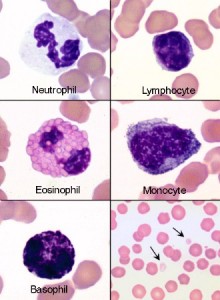Equine neutrophils tend to be the least lobulated of domestic species and have irregular versus distinctly segmented nuclei. Granules are not readily discernible in the cytoplasm, which is colorless. Neutrophils outnumber lymphocytes in healthy horses and lymphocytes are usually small. Eosinophils resemble raspberries and have large red granules. Basophils are similar to those seen in cattle, with prominent purple granules, similar to tissue mast cells. Equine red blood cells are similar to those of cats with regard to size and degree of anisocytosis. They lack central pallor. Compared to other species, horse red blood cells have a marked tendency to form rouleaux formation (altered zeta potential) and settle quickly on standing, so equine blood should be well-mixed before analysis. Polychromatophilic red blood cells are absent in blood of non-anemic horses and are rare even in blood of horses with regenerative anemia. A few Howell-jolly bodies may be seen in some red blood cells. Equine platelets are smooth discs with faint granules and they can be difficult to see (arrows). Platelet size is small and uniform. Horses have lower platelet counts than other species (100-200 thousand/uL).

